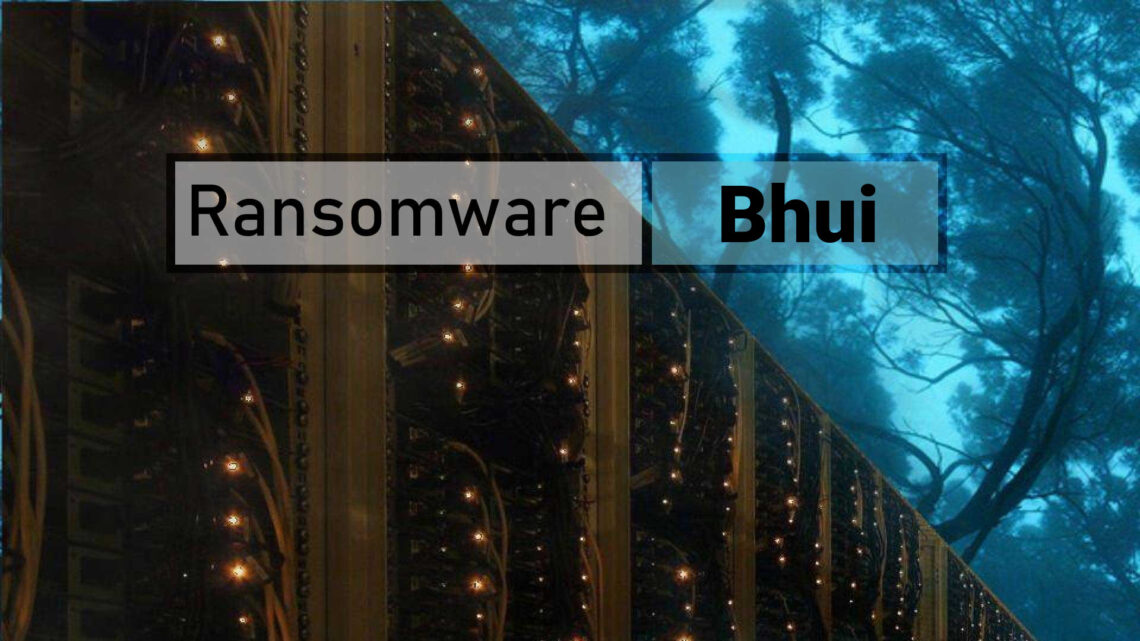While analyzing malware samples submitted to VirusTotal1, I have identified the presence of Bhui ransomware, which belongs to the STOP/Djvu ransomware family. Once a computer becomes infected, Bhui proceeds to encrypt files and adds the “.bhui” extension to their original filenames. For instance, a file named “a.jpg” would be renamed as “a.jpg.bhui“, while “b.doc” would be transformed into “b.doc.bhui“.
Additionally, apart from encrypting files, Bhui generates a ransom note in the form of a text file named “_readme.txt“. Furthermore, the distribution of Bhui may involve the utilization of information stealers such as Vidar and RedLine.
The ransom note places significant emphasis on the fact that file decryption is solely achievable through the utilization of dedicated decryption software and an exclusive key. To initiate the data decryption process, victims are explicitly instructed to establish contact with the attackers via the provided email addresses (support@freshmail.top or datarestorehelp@airmail.cc).
Moreover, the ransom note presents two distinct amounts, namely $980 and $490, indicating that victims have the opportunity to acquire the decryption tools at a discounted price if they initiate communication with the attackers within a 72-hour window.
The Bhui key is unique for every victim, with one limitation:
- If Bhui is not able to establish a connection to its command and control server (C&C Server) prior to beginning its encryption procedure, then it will use the offline key. The key used is the same across all users, which makes it feasible to decrypt files encrypted in a ransomware attack.
What is Bhui Virus File?
☝️ Bhui ransomware can be identify as a STOP/DJVU malware family.
The Bhui virus is basically similar to other representatives of the same DJVU family: TGVV, Ahtw, Ahui. The image below gives a clear vision of how the files with “.bhui” extension look like:
| Name | Bhui Virus |
| Ransomware family2 | DJVU/STOP3 ransomware |
| Extension | .bhui |
| Ransomware note | _readme.txt |
| Ransom | From $490 to $980 (in Bitcoins) |
| Contact | support@fishmail.top, datarestorehelp@airmail.cc |
| Detection | Ransom:Win32/StopCrypt.PBM!MTB, Ransom:Win32/StopCrypt.PA!MTB |
| Symptoms |
|
| Fix Tool | To remove possible malware infections, scan your PC: 6-day free trial available. |
This _readme.txt file asking payment is for restore files via decryption key:
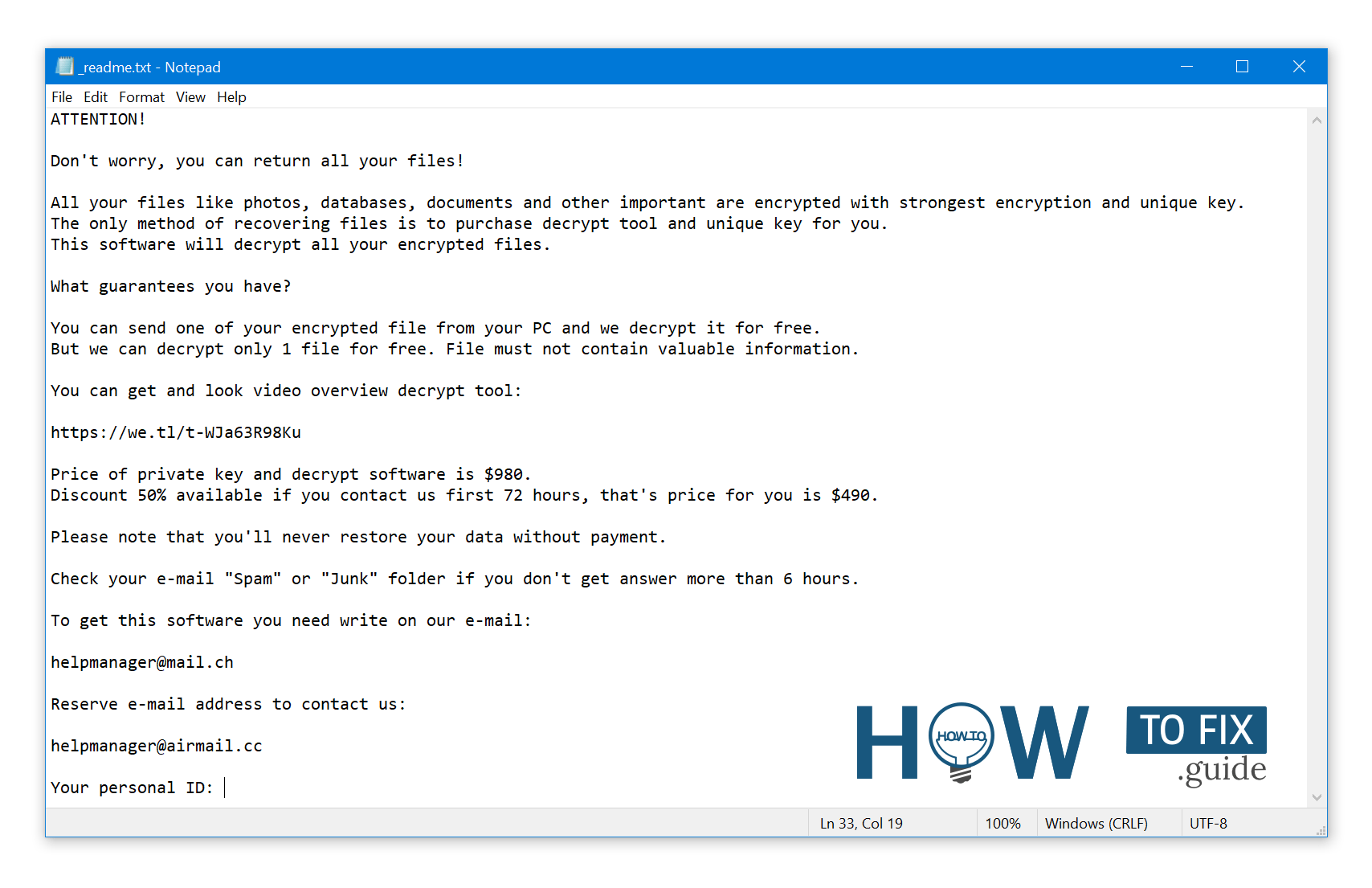
_readme.txt (STOP/DJVU Ransomware) – The scary alert demanding from users to pay the ransom to decrypt the encoded data contains these frustrating warnings
Bhui ransomware arrives as a set of processes that are meant to perform different tasks on a victim’s computer. One of the first ones being launched is winupdate.exe, a tricky process that displays a fake Windows update prompt during the attack. This is meant to convince the victim that a sudden system slowdown is caused by a Windows update. However, at the same time, the ransomware runs another process (usually named by four random characters) which starts scanning the system for target files and encrypting them. Next, the ransomware deletes Volume Shadow Copies from the system using the following CMD command:
vssadmin.exe Delete Shadows /All /Quiet
Once deleted, it becomes impossible to restore the previous computer state using System Restore Points. The thing is, ransomware operators are getting rid of any Windows OS-based methods that could help the victim to restore files for free. In addition, the crooks modify the Windows HOSTS file by adding a list of domains to it and mapping them to the localhost IP. As a result, the victim will run into a DNS_PROBE_FINISHED_NXDOMAIN error when accessing one of the blocked websites.
We noticed that ransomware attempts to block websites that publish various how-to guides for computer users. It is evident that by restricting specific domains, the crooks are trying to prevent the victim from reaching relevant and helpful ransomware-attack-related information online. The virus also saves two text files on the victim’s computer that provide attack-related details – the victim’s public encryption key and personal ID. These two files are called bowsakkdestx.txt and PersonalID.txt.
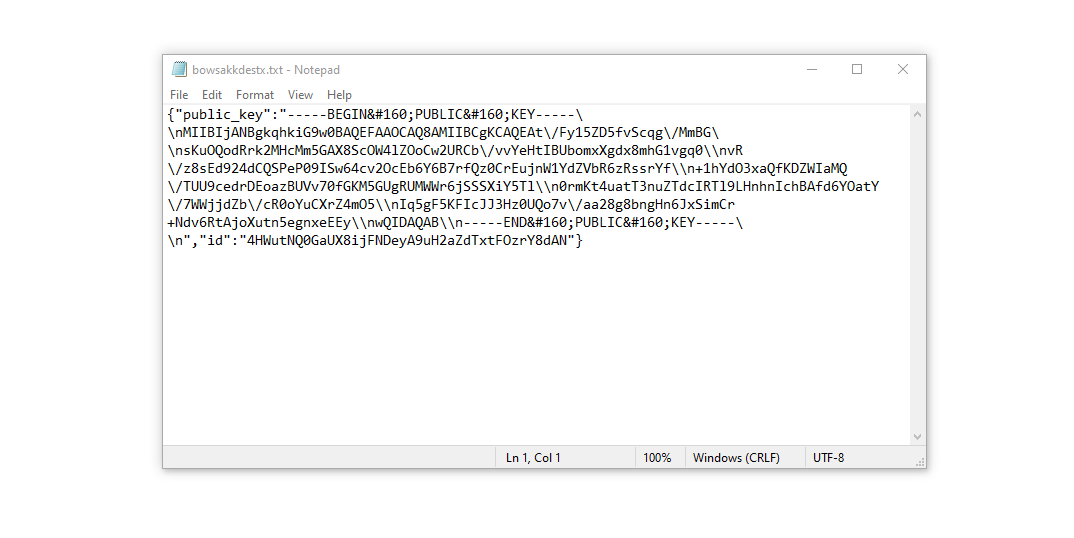
After all these modifications, the malware doesn’t stop. Variants of STOP/DJVU tend to drop Vidar password-stealing Trojan on compromised systems. This threat has a lengthy list of capabilities, such as:
- Stealing Steam, Telegram, Skype login/password;
- Stealing cryptocurrency wallets;
- Downloading malware to the computer and running it;
- Stealing browser cookies, saved passwords, browsing history, and more;
- Viewing and manipulating files on victim’s computer;
- Allowing the hackers to perform other tasks on the victim’s computer remotely.
The cryptography algorithm used by DJVU/STOP ransomware is AES-256. So, if your documents got encrypted with an online decryption key, which is totally unique. The sad reality is that it is impossible to decrypt the files without the unique key.
In case if Bhui worked in online mode, it is impossible for you to gain access to the AES-256 key. It is stored on a remote server owned by the criminals who promote the Bhui virus.
For receiving decryption key the payment should be $980. To obtain the payment details, the victims are encouraged by the message to contact the frauds by email (support@fishmail.top).
The message by the ransomware states the following information:
ATTENTION! Don't worry, you can return all your files! All your files like photos, databases, documents and other important are encrypted with strongest encryption and unique key. The only method of recovering files is to purchase decrypt tool and unique key for you. This software will decrypt all your encrypted files. What guarantees you have? You can send one of your encrypted file from your PC and we decrypt it for free. But we can decrypt only 1 file for free. File must not contain valuable information. You can get and look video overview decrypt tool: https://we.tl/t-WJa63R98Ku Price of private key and decrypt software is $980. Discount 50% available if you contact us first 72 hours, that's price for you is $490. Please note that you'll never restore your data without payment. Check your e-mail "Spam" or "Junk" folder if you don't get answer more than 6 hours. To get this software you need write on our e-mail: support@fishmail.top Reserve e-mail address to contact us: datarestorehelp@airmail.cc Your personal ID: XXXXXXXXXXXXXXXXXXXXXXXXXXXXXXX
Do not pay for Bhui!
Please, try to use the available backups, or Decrypter tool
I strongly advise against contacting these fraudulent individuals and making any payments. One of the most reliable and effective solutions for recovering lost data is to utilize available backups or employ a Decrypter tool.
The peculiarity of all such ransomware viruses is that they follow a similar set of actions to generate a unique decryption key for recovering the encrypted data. Unless the ransomware is still in the developmental stage or possesses hard-to-track flaws, manually recovering the encrypted data is practically impossible. Regularly creating backups of crucial files is the only viable solution to prevent the loss of valuable data.
It is important to note that even if you maintain regular backups, they should be stored in a specific location that is separate from your main workstation. This means they should not be connected to your main computer. For example, you can keep your backups on a USB flash drive or an alternative external hard drive storage. Another option is to utilize online (cloud) information storage services.
It is crucial to understand that if you store your backup data on your main PC, it can also be subject to encryption, just like your other data. Therefore, it is not advisable to keep your backups on your main computer to ensure their safety and accessibility.
How I was infected?
Ransomware has a various methods to built into your PC.
Ransomware employs several methods to infect computers and compromise their files. Understanding these tactics can help you better protect your system against such threats.
One common avenue for ransomware infection is through websites that distribute pirated software or falsely promise downloads of popular YouTube videos. Unscrupulous individuals take advantage of users seeking free access to software or entertainment, embedding malicious code within the files or providing deceptive download links.
Another prevalent method is through emails containing malicious links or attachments. Cybercriminals craft convincing emails that appear legitimate, luring unsuspecting users into clicking on a link or opening an attachment. Once activated, the ransomware quickly infiltrates the system, initiating the encryption process.
Ransomware can also propagate through peer-to-peer (P2P) networks, where users share files directly with one another. These networks provide an environment where malware can easily disguise itself as a legitimate file, tricking users into downloading and executing it, thereby initiating the ransomware attack.
Free file hosting platforms and third-party downloaders pose additional risks. Cybercriminals exploit these platforms by uploading infected files or modifying legitimate files to include malicious code. Users who download files from these sources unknowingly introduce ransomware into their systems.
Trojans, a type of malware that disguises itself as a legitimate program, can also serve as a delivery mechanism for ransomware. These Trojans may be disguised as harmless files or bundled with legitimate software, deceiving users into installing them. Once the Trojan is activated, it unleashes the ransomware payload.
Upon successful infiltration, ransomware employs a variety of file types to carry out its malicious actions. PDF documents, Microsoft Office files, JavaScript files, executable files with the .exe extension, and archive files like ZIP and RAR are commonly used to deliver the ransomware payload. This diversity allows the threat actors to exploit different avenues of attack, increasing the chances of successful infection.
It is essential to remain vigilant and exercise caution while browsing the internet, opening emails, and downloading files. Regularly updating your security software, backing up your files, and practicing safe computing habits can significantly reduce the risk of falling victim to ransomware.
How To Remove Bhui Virus?
In addition to encode a victim’s files, the Bhui infection has also started to install the Vidar Stealer on computer to steal account credentials, cryptocurrency wallets, desktop files, and more.
Reasons why I would recommend GridinSoft4
There is no better way to recognize, remove and prevent ransomware than to use an Gridinsoft Anti-malware.
Download Removal Tool.
You can download GridinSoft Anti-Malware by clicking the button below:
Run the setup file.
When setup file has finished downloading, double-click on the setup-antimalware-fix.exe file to install GridinSoft Anti-Malware on your PC.

An User Account Control asking you about to allow GridinSoft Anti-Malware to make changes to your device. So, you should click “Yes” to continue with the installation.

Press “Install” button.

Once installed, Anti-Malware will automatically run.

Wait for complete.
GridinSoft Anti-Malware will automatically start scanning your PC for Bhui infections and other malicious programs. This process can take a 20-30 minutes, so I suggest you periodically check on the status of the scan process.

Click on “Clean Now”.
When the scan has completed, you will see the list of infections that GridinSoft Anti-Malware has detected. To remove them click on the “Clean Now” button in right corner.

Trojan Killer for special instances
In some certain instances, Bhui ransomware can block the running of setup files of different anti-malware programs. In this situation, you need to utilize the removable drive with a pre-installed antivirus tool.
There is a really little number of security tools that are able to be set up on the USB drives, and antiviruses that can do so in most cases require to obtain quite an expensive license. For this instance, I can recommend you to use another solution of GridinSoft – Trojan Killer Portable. It has a 14-days cost-free trial mode that offers the entire features of the paid version 5. This term will definitely be 100% enough to wipe malware out.
How To Decrypt .bhui Files?
Restore solution for big “.bhui files“
Try removing .bhui extension on a few BIG files and opening them. Either the Bhui infection read and did not encrypt the file, or it bugged and did not add the filemarker. If your files are very large (2GB+), the latter is most likely. Please, let me know in comments if that will work for you.
The newest extensions released around the end of August 2019 after the criminals made changes. This includes Neqp, Nerz, Neon, etc.
As a result of the changes made by the criminals, STOPDecrypter is no longer supported. It has been removed and replaced with the Emsisoft Decryptor for STOP Djvu Ransomware developed by Emsisoft.
You can download free decryption tool here: Decryptor for STOP Djvu.
Download and run decryption tool.
Start downloading the decryption tool.
Make sure to launch the decryption utility as an administrator. You need to agree with the license terms that will come up. For this purpose, click on the “Yes” button:
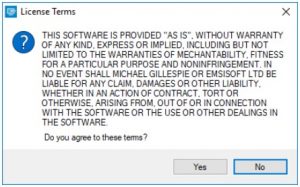
As soon as you accept the license terms, the main decryptor user interface comes up:
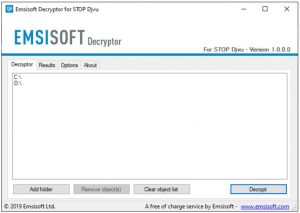
Select folders for decryption.
Based on the default settings, the decryptor will automatically populate the available locations in order to decrypt the currently available drives (the connected ones), including the network drives. Extra (optional) locations can be selected with the help of the “Add” button.
Decryptors normally suggest several options considering the specific malware family. The current possible options are presented in the Options tab and can be activated or deactivated there. You may locate a detailed list of the currently active Options below.
Click on the “Decrypt” button.
As soon as you add all the desired locations for decryption into the list, click on the “Decrypt” button in order to initiate the decryption procedure.
Note that the main screen may turn you to a status view, letting you know of the active process and the decryption statistics of your data:
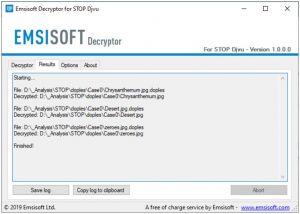
The decryptor will notify you as soon as the decryption procedure is completed. If you need the report for your personal papers, you can save it by choosing the “Save log” button. Note that it is also possible to copy it directly to your clipboard and to paste it into emails or messages here if you need to do so.
The Emsisoft Decryptor might display different messages after a failed attempt to restore your bhui files:
✓ Error: Unable to decrypt file with ID: [your ID]
✓ No key for New Variant online ID: [your ID]
Notice: this ID appears to be an online ID, decryption is impossible
✓ Result: No key for new variant offline ID: [example ID]
This ID appears be an offline ID. Decryption may be possible in the future.
It can take a few weeks or months until the decryption key gets found and uploaded to the decryptor. Please follow updates regarding the decryptable DJVU versions here.
✓ Remote name could not be resolved
How to Restore .bhui Files?
In some case Bhui ransomware is not doom for your files…
Bhui ransomware encryption mechanism feature is next: it encrypts every file byte-by-byte, then saves a file copy, deleting (and not overriding!) the original file. Hence, the information of the file location on the physical disk is lost, but the original file is not deleted from the physical disk. The cell, or the sector where this file was stored, can still contain this file, but it is not listed by the file system and can be overwritten by data that has been loaded to this disk after the deletion. Hence, it is possible to recover your files using special software.
Anyway, after realizing it was an online algorithm, it is impossible to retrieve my encrypted files. I also had my backup drive plugged in at the time of the virus, and this was also infected, or so I thought. Every folder within my backup drive had been infected and was encrypted. However, despite losing some important files, I retrieved almost 80% of my 2TB storage.
When I started going through the folders, I noticed the readme.txt ransom note in every folder. I opened some of the folders and found that all files that were not in a subfolder within that folder had been encrypted. However, I found a flaw and glimmer of hope when I went into the subfolders in other folders and found that these files had not been encrypted. Every folder within my c and d drives, including subfolders, had been encrypted, but this was not the case with the backup drive. Having subfolders created within a folder has saved 80% of my data.
As I said, I believe this to be only a small loophole on a backup drive. I’ve since found a further 10 % of my data on another hard drive on a different pc. So my advice is if you use a backup drive, create subfolders. I was lucky, I guess. But I was also unlucky that the virus hit as I was transferring some files from my backup.
Hopefully, this can help some other people in my situation.
Jamie NewlandRecovering your files with PhotoRec
PhotoRec is an open-source program, which is originally created for files recovery from damaged disks, or for files recovery in case if they are deleted. However, as time has gone by, this program got the ability to recover the files of 400 different extensions. Hence, it can be used for data recovery after the ransomware attack
At first, you need to download this app. It is 100% free, but the developer states that there is no guarantee that your files will be recovered. PhotoRec is distributed in a pack with other utility of the same developer – TestDisk. The downloaded archive will have TestDisk name, but don’t worry. PhotoRec files are right inside.
To open PhotoRec, you need to find and open “qphotorec_win.exe” file. No installation is required – this program has all the files it need inside of the archive, hence, you can fit it on your USB drive, and try to help your friend/parents/anyone who was been attacked by DJVU/STOP ransomware.
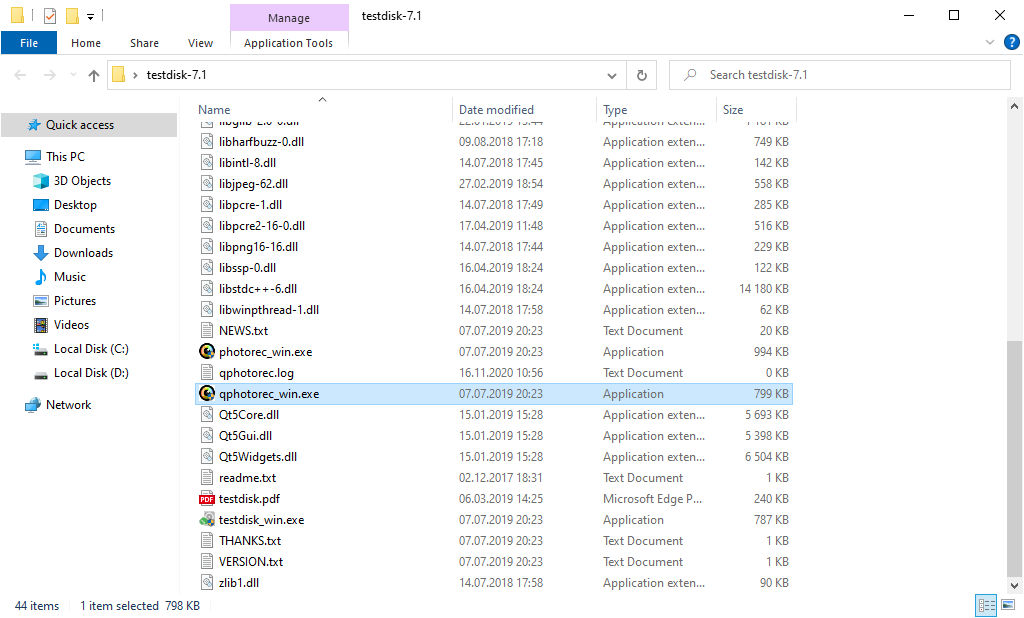
After the launch, you will see the screen showing you the full list of your disk spaces. However, this information is likely useless, because the required menu is placed a bit higher. Click this bar, then choose the disk which was attacked by ransomware.
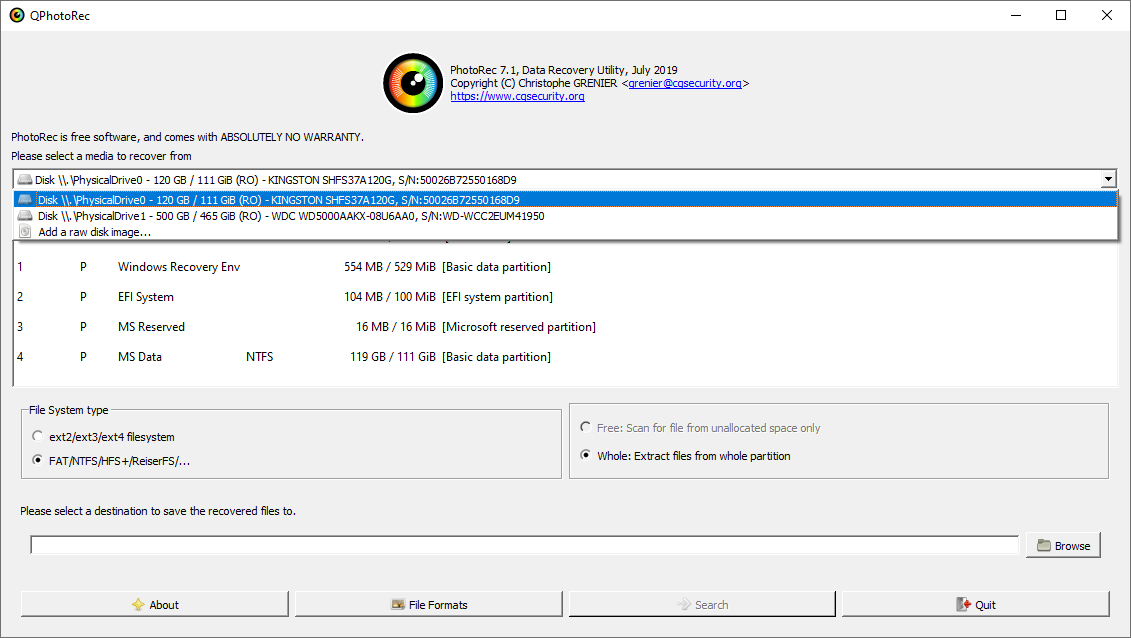
After choosing the disk, you need to choose the destination folder for the recovered files. This menu is located at the lower part of the PhotoRec window. The best desicion is to export them on USB drive or any other type of removable disk.
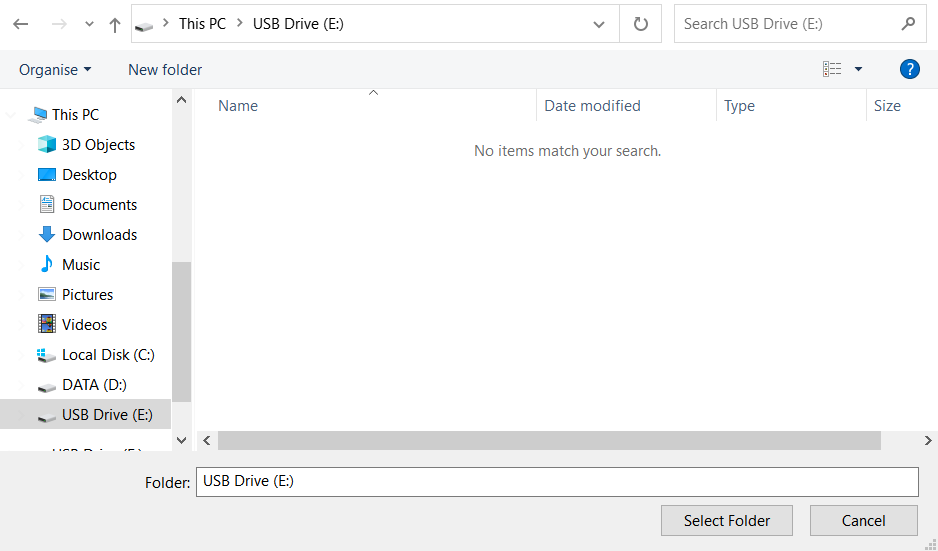
Then, you need to specify the file formats. This option is located at the bottom, too. As it was mentioned, PhotoRec can recover the files of about 400 different formats.
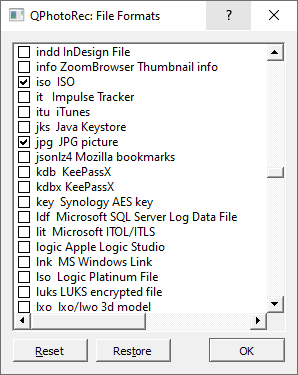
Finally, you can start files recovery by pressing the “Search” button. You will see the screen where the results of the scan and recovery are shown.
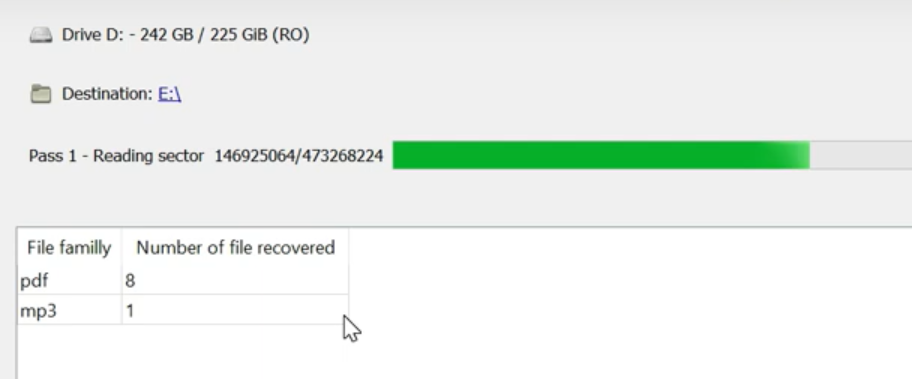
Bhui files recovery guide
Frequently Asked Questions
No way. These files are modified by ransomware. The contents of .bhui files are not available until they are decrypted.
If your data remained in the .bhui files are very valuable, then most likely you made a backup copy.
If not, then you can try to restore them through the system function – Restore Point.
All other methods will require patience.
Of course not. Your encrypted files do not pose a threat to the computer. What happened has already happened.
You need GridinSoft Anti-Malware to remove active system infections. The virus that encrypted your files is most likely still active and periodically runs a test for the ability to encrypt even more files. Also, these viruses install keyloggers and backdoors for further malicious actions (for example, theft of passwords, credit cards) often.
In this situation, you need to prepare the memory stick with a pre-installed Trojan Killer.
Have patience. You are infected with the new version of STOP/DJVU ransomware, and decryption keys have not yet been released. Follow the news on our website.
We will keep you posted on when new Bhui keys or new decryption programs appear.
The Bhui ransomware encrypts only the first 150KB of files. So MP3 files are rather large, some media players (Winamp for example) may be able to play the files, but – the first 3-5 seconds (the encrypted portion) will be missing.
You can try to find a copy of an original file that was encrypted:
- Files you downloaded from the Internet that were encrypted and you can download again to get the original.
- Pictures that you shared with family and friends that they can just send back to you.
- Photos that you uploaded on social media or cloud services like Carbonite, OneDrive, iDrive, Google Drive, etc)
- Attachments in emails you sent or received and saved.
- Files on an older computer, flash drive, external drive, camera memory card, or iPhone where you transferred data to the infected computer.
Video Guide
How to use GridinSoft Anti-Malware for remove ransomware.
If the guide doesn’t help you to remove Bhui virus, please download the GridinSoft Anti-Malware that I recommended. Do not forget to share your experience in solving the problem. Please leave a comment here! This can help other victims to understand they are not alone. And together we will find ways to deal with this issue.
I need your help to share this article.
It is your turn to help other people. I have written this article to help people like you. You can use buttons below to share this on your favorite social media Facebook, Twitter, or Reddit.
Brendan SmithBHUI Ransomware — How To Restore & Decrypt Files?
Name: BHUI Virus
Description: BHUI Virus is a STOP/DJVU family of ransomware-type infections. This virus encrypts your files, video, photos, documents that can be tracked by a specific bhui extension. So, you can't use them at all after that BHUI ransomware asks victims for a ransom fee ($490 - $980) in Bitcoin.
Operating System: Windows
Application Category: Virus
User Review
( votes)References
- Sample of BHUI Virus Rasnomware: VirusTotal.com
- My files are encrypted by ransomware, what should I do now?
- About DJVU (STOP) Ransomware.
- GridinSoft Anti-Malware Review from HowToFix site: https://howtofix.guide/gridinsoft-anti-malware/
- Trojan Killer Review: https://howtofix.guide/trojan-killer/
![]() German
German ![]() Japanese
Japanese ![]() Spanish
Spanish ![]() Portuguese (Brazil)
Portuguese (Brazil) ![]() French
French ![]() Turkish
Turkish ![]() Chinese (Traditional)
Chinese (Traditional) ![]() Korean
Korean ![]() Indonesian
Indonesian ![]() Hindi
Hindi ![]() Italian
Italian

